The AORUS Gen5 12000 SSD marks another entry into the PCIe Gen5 realm. This drive is essentially an update to the AORUS 10000 SSD, which we reviewed earlier this year, featuring the new Micron 232-layer NAND as the primary change between the two models. The new GIGABYTE SSD is powered by the Phison PS5026-E26 controller and is targeted toward PC enthusiasts, gamers, and professionals in rendering.
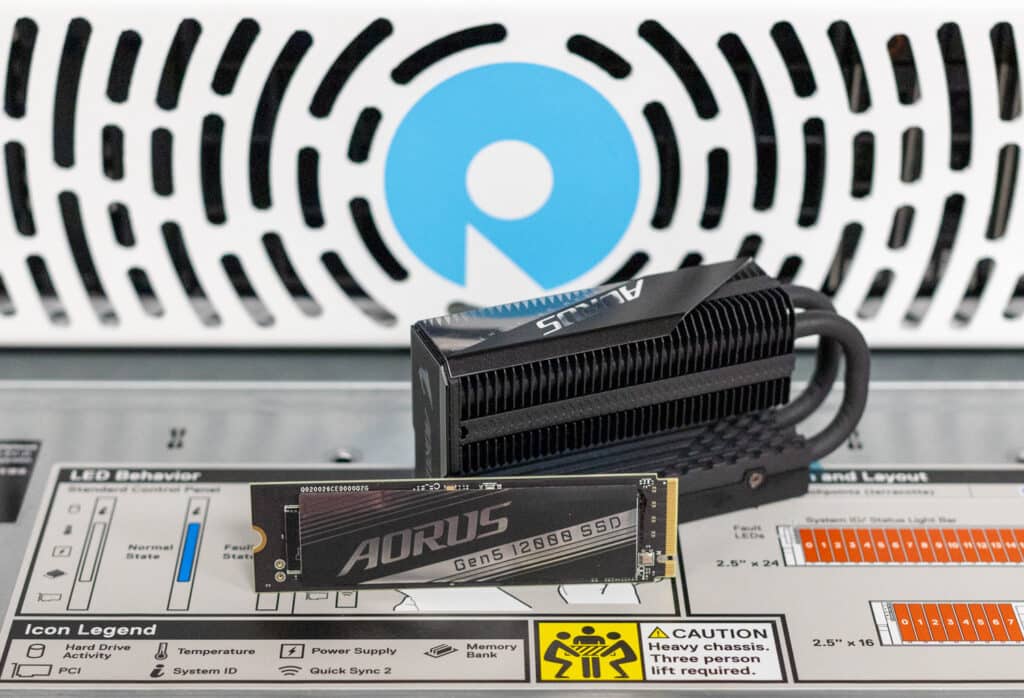
Sequential read and write speeds are quoted to reach up to 11,700 MB/s and 9,500 MB/s, respectively, which theoretically puts it ahead of many PCIe Gen4 SSDs. However, despite these impressive specifications, you will see that our performance benchmarking didn’t yield particularly good results. Drives using the Phison E26 have generally shown strong straight-line numbers, but are unable to outperform the high-end Gen4 SSDs in a number of tests.
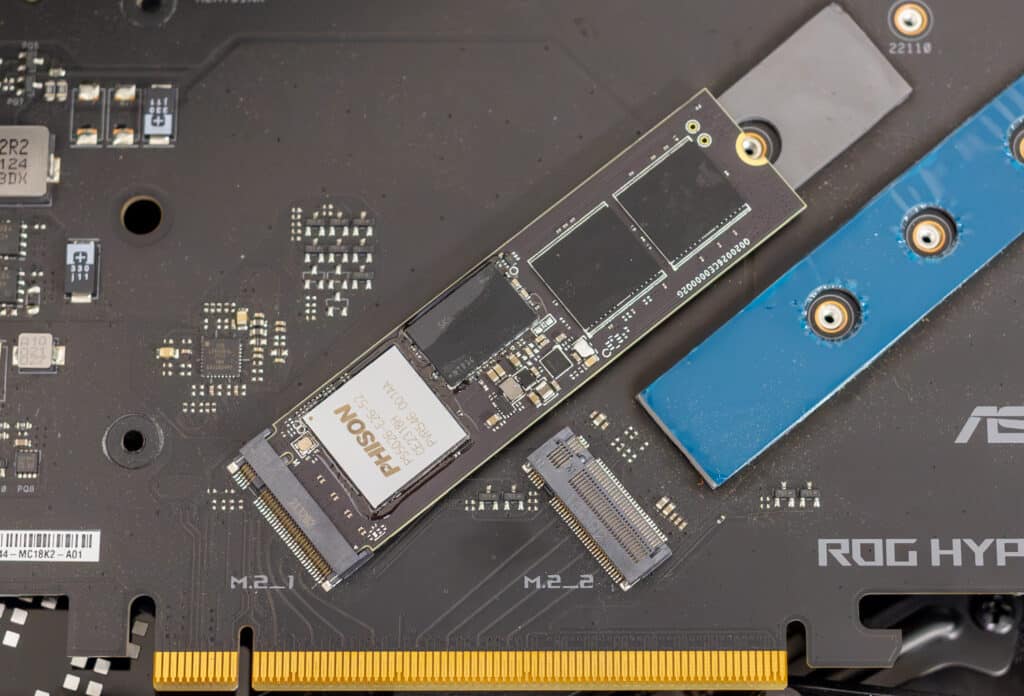
Nonetheless, it is worth mentioning that this SSD is competitively priced at $154 on NewEgg at the time of writing. That makes it cheaper than the Firecuda 540, which uses older NAND technology and is priced at $180. While this lower price tag may initially seem appealing, it’s important to note that a reduced cost doesn’t necessarily translate to better overall value when it comes to SSDs. Quality, performance, and reliability are also key factors that should be considered to accurately assess their true worth.
GIGABYTE Aorus 12000 Design and Build
Physically, the AORUS 12000 SSD offers a robust build quality. It comes with an optional M.2 Thermal Guard XTREME, which features dual heat pipes and stacked fins coated with advanced Nanocarbon thermal technology.
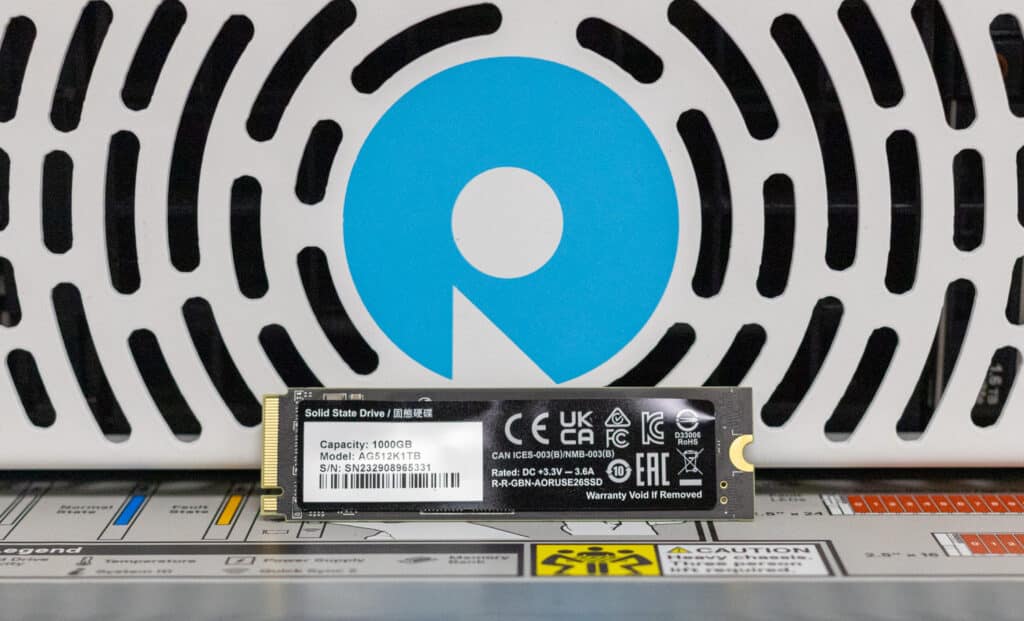
The aluminum M2 baseplate and dual-side high thermal conductivity pad aim to transfer heat effectively to these stacked fins, ensuring maximum heat dissipation. This is particularly important given that higher working temperatures can sometimes lead to data loss and degrade performance, so this may be an interesting choice for those who are running systems with passive airflow or using CPU AIO water coolers.
Backed by a limited 5-year warranty, the AORUS 12000 Gen5 SSD goes for roughly $154 and $265 for the 1TB and 2TB models, respectively. We will be looking at the 1TB model for this review.
GIGABYTE Aorus 12000 Specifications
| Interface: | PCI-Express 5.0×4, NVMe 2.0 |
| Form Factor: | M.2 2280 |
| Capacity: | 1TB, 2TB |
| NAND: | 3D TLC NAND Flash |
| External DDR Cache: | LPDDR4 2GB |
| Sequential Read speed: | Up to 11,700 MB/s |
| Sequential Write speed: | Up to 9,500MB/s |
| Dimensions: | SSD without Heatsink: 80 x 22 x 3.5mm SSD with Heatsink: 92 x 23.5 x 44.7 mm |
| Mean time between failure (MTBF): | 1.6 million hours |
| Max. Operating Power: | 11W |
| Power Consumption (Idle, PS3): | <144mW |
| Power Consumption (PS4, L1.2): | <85mW |
| Temperature (Operating): | 0°C to 70°C |
| Temperature (Storage): | -40°C to 85°C |
| Warranty: | Limited 5-years or 700TBW. Limited warranty based on 5 years or 700TBW, whichever comes first. |
GIGABYTE Aorus 12000 Performance
For this review, we will be looking at the 1TB model. Comparables are a mixture of popular Gen4 SSDs and the first wave of Gen5 SSDs. The other tested Gen5 SSDs are equipped with the Phison E26 platform:
For testing, we use two platforms. The consumer test platform supports PCIe Gen4/Gen5 SSDs and is sometimes leveraged for lighter consumer-based tests such as BlackMagic DiskSpeed Test and CrystalDiskMark, and our main platform, a Dell PowerEdge R760, which overlaps with our enterprise tests. For ultimate flexibility, we worked with Serial Cables, who supplied us with an 8-bay PCIe Gen5 JBOF for U.2/U.3, M.2, and E1.S/E3.S drive testing. This allows us to test all current and emerging drive types on the same test hardware.
Dell PowerEdge R760 Configuration
- Dual Intel Xeon Gold 6430 (32 cores/64 threads, 1.9GHz base)
- 1TB DDR5 RAM
- Ubuntu 22.04
VDBench Workload Analysis
When benchmarking storage devices, application testing is best, and synthetic testing is second. While not a perfect representation of actual workloads, synthetic tests help baseline storage devices with a repeatability factor that makes it easy to compare competing solutions. These workloads offer a range of testing profiles ranging from “four corners” tests and common database transfer size tests to trace captures from different VDI environments.
These tests leverage the common vdBench workload generator, with a scripting engine to automate and capture results over a large compute testing cluster. This allows us to repeat the same workloads across various storage devices, including flash arrays and individual storage devices. Our testing process for these benchmarks fills the entire drive surface with data, then partitions a drive section equal to one percent of the drive capacity to simulate how the drive might respond to application workloads. This differs from full entropy tests, which use 100 percent of the drive and take them to a steady state. As a result, these figures will reflect higher-sustained write speeds.
Profiles:
- 4K Random Read: 100% Read, 128 threads, 0-120% iorate
- 4K Random Write: 100% Write, 64 threads, 0-120% iorate
- 64K Sequential Read: 100% Read, 16 threads, 0-120% iorate
- 64K Sequential Write: 100% Write, 8 threads, 0-120% iorate
- VDI Profiles
Starting with 4K random read, the GIGABYTE Aorus 12000 Gen5 drive was far behind the leaders and close to its predecessor in performance, hitting 770K IOPS at 165.5ms. The Gen4 Solidigm P44 Pro SSD was the best-performingdrive here.
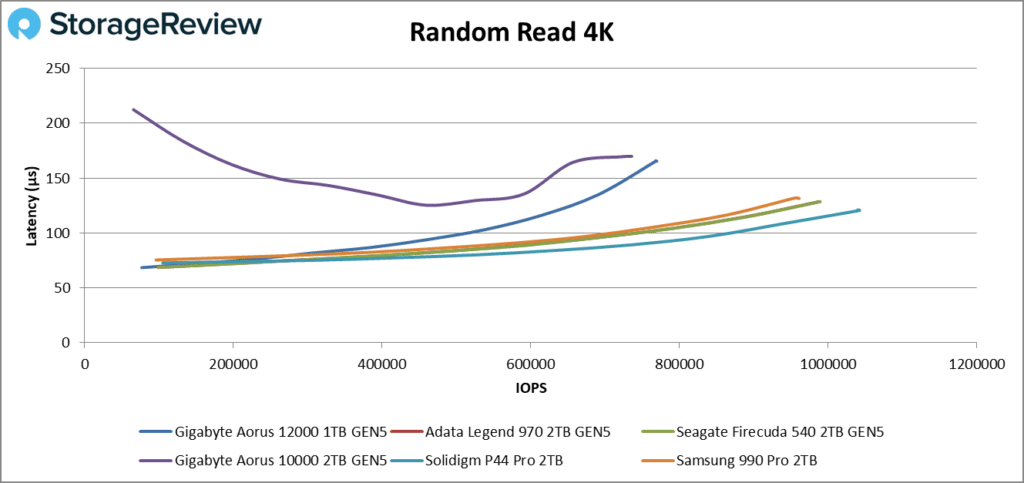
The Aorus 12000 Gen5 SSD faired the same when it came to writes, taking second last only surpassing the Solidigm drive. Here, it peaked with a speed of 264k IOPS and a latency of 198.8µs, which was slower than its older Aorus counterpart.
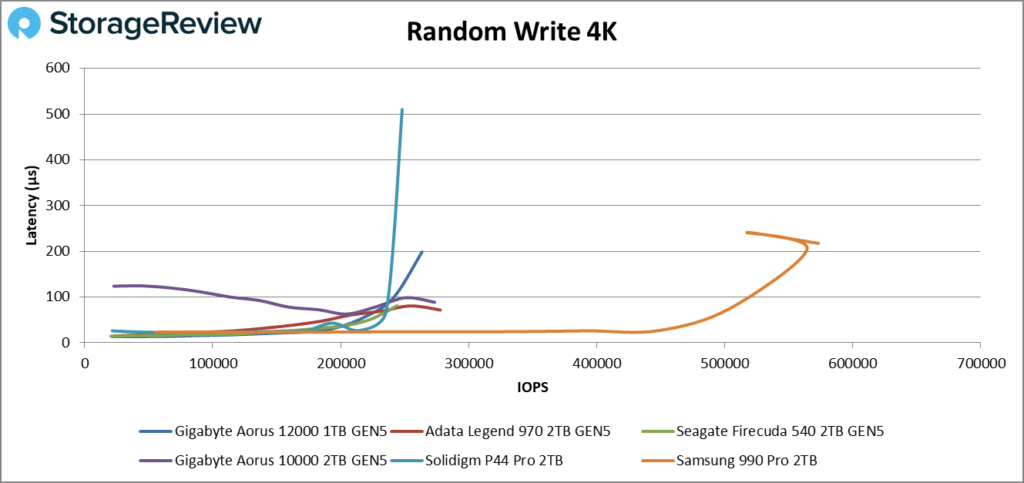
When switching to the sequential read 64k workload, the Aorus 12000 performed moderately better, placing 3rd overall. It ended the test at a speed of 5.77GB/s and a latency of 346.1µs.
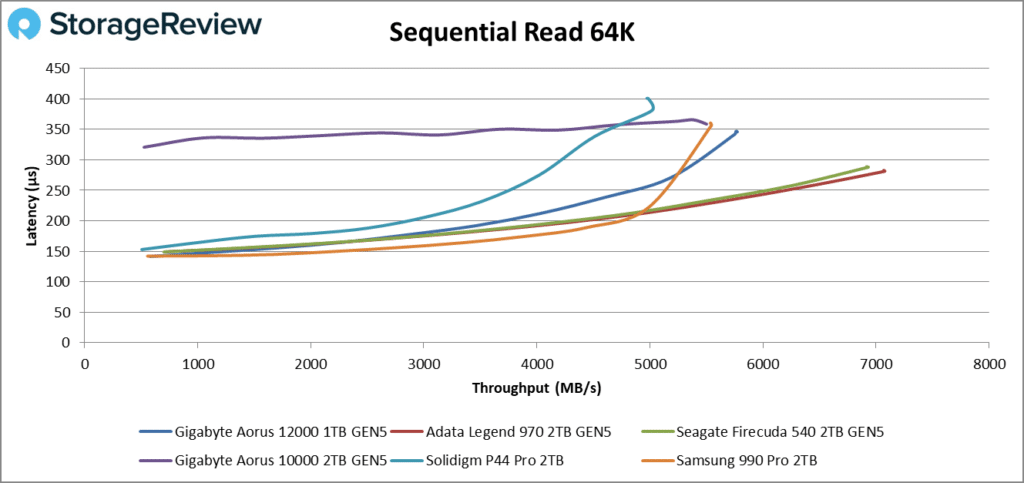
Unfortunately, the Aorus 12000 fell way back to last place in sequential writes. The drive peaked at just a hair over 1GB/s at a latency of over 1,000µs at the end of the test. Its predecessor performed much better with 1.4GB/s.
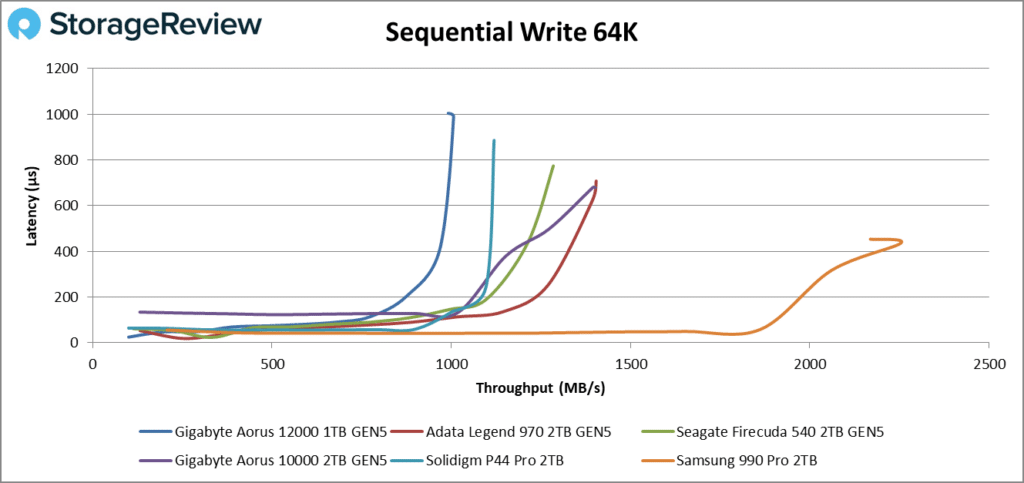
Next, we looked at our VDI benchmarks, designed to tax the drives further. These tests include Boot, Initial Login, and Monday Login. Starting with boot, the Aorus 12000 had fairly weak results, peaking at around 140K IOPS at 236.1ms.
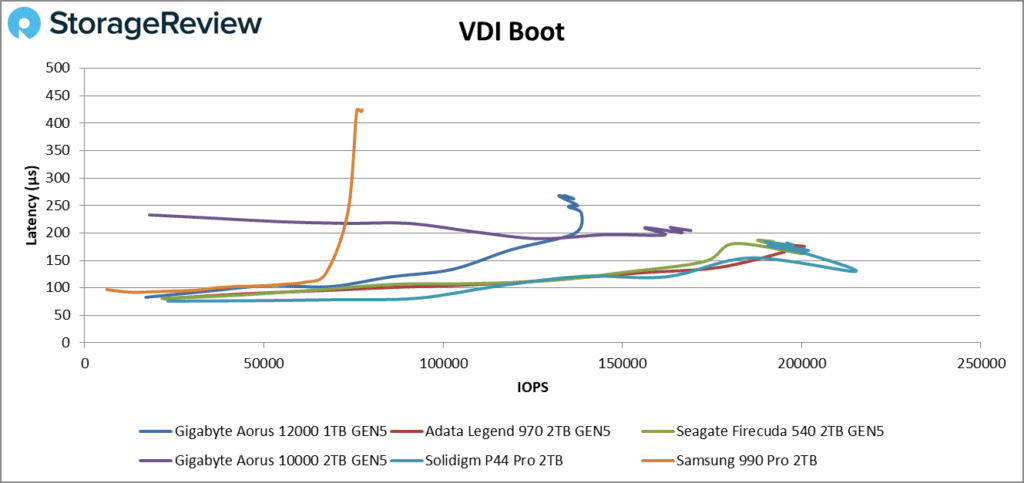
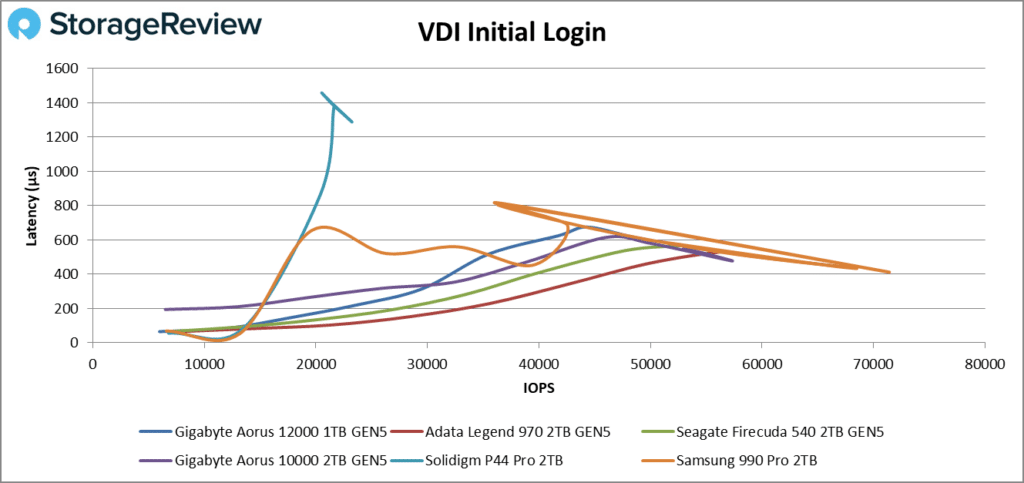
Lastly, we have the VDI Monday Login benchmark, which actually showed some pretty solid results. Taking third place, the Aorus 12000 peaked at 41K IOPS at a latency of 388.7ms.
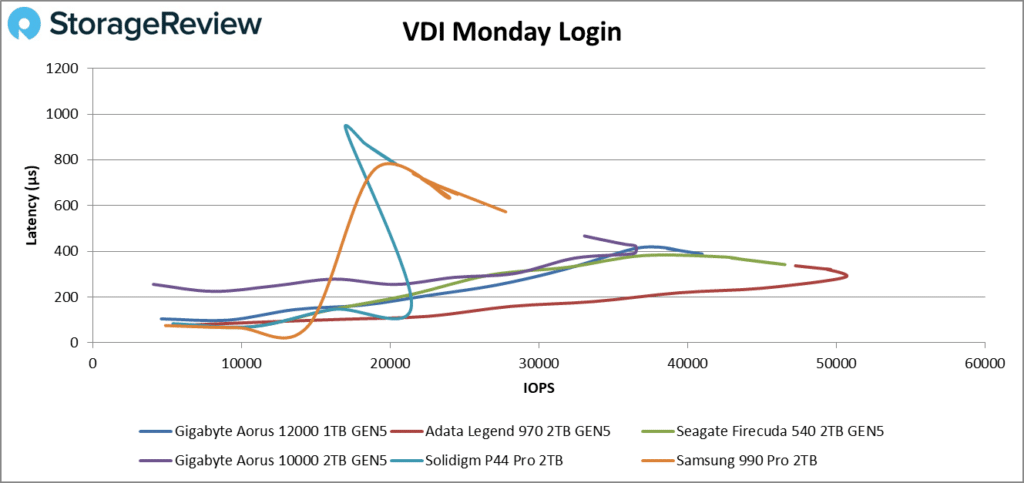
BootBench
BOOT-BENCH-1 is a workload profile adopted by OCP to profile SSDs designed for server boot duty. While this is intuitively a job for enterprise SSDs, client SSDs are often selected for their performance, capacity, and cost combination. The boot drive issue is germane not just to hyperscalers but also to server and storage system providers, as they face similar challenges.
This boot workload executes a relatively intense test plan that fills the entire drive with writes before testing a read-heavy workload sequence. For each test, it performs a 32K random read async operation alongside a 15MiB/s synchronous 128k random write and a 5MiB/s synchronous 128k random write/trim background workload. The script starts with the random-read activity at a 4-job level and scales up to 256-jobs at its peak. The final result is the read-operations performed during its peak run.
The OCP goal for this benchmark is a pass/fail at 60K read IOPS. Most drives we test will far exceed the minimum, but the results are instructive regardless.
Unfortunately, like its predecessor, the Arorus 12000 is another SSD to get a “DNF” due to its poor latency and IOPS that did not make the cut-off. To date, many of the Phison E26 Gen5 consumer SSDs have failed this test, with a couple barely passing.
Here is the current boot leaderboard:
| SSD | Read IOPS |
| Sk hynix Platinum P41 | 220,884 IOPS |
| WD SN850X | 219,883 IOPS |
| Solidigm P44 Pro | 211,999 IOPS |
| Fantom VENOM8 | 190,573 IOPS |
| Samsung 990 Pro | 176,677 IOPS |
| Sabrent Rocket 4 Plus | 162,230 IOPS |
| ADATA Legend 970 | 65,632 IOPS |
| Predator Storage GM7 | 35,302 IOPS |
| Aorus 12000 | DNF |
CrystalDiskMark Speed Test
We performed a lighter-weight test on the GIGABYTE Aorus 12000 to demonstrate its Gen5 speeds. Using CrystalDiskMark, the drive recorded sequential transfer speeds exceeding 10GB/s for both read and write, showing 11.7GB/s for reads and 9.5GB/s for writes. Interestingly, the CrystalDiskMark results aligned precisely with what was outlined in the specification sheet; a rare coincidence that, while not particularly meaningful, is something we seldom see.
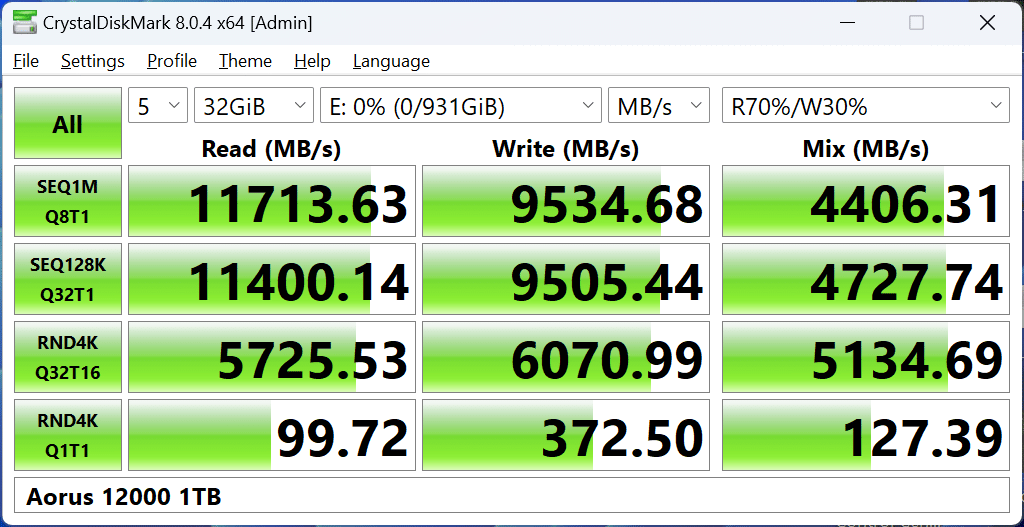
CrystalDiskMark’s higher queue depth (compared to BlackMagic) allows us to showcase the best-case scenario for the drive. These test results among comparable drives were so closely matched that any real-world performance differences would likely be negligible.
| CDM Speed Test | GIGABYTE Aorus 12000 | ADATA Legend 970 | GIGABYTE Aorus 10000 | Seagate Firecuda 540 |
| Write | 9.5GB/s | 10.08GB/s | 10.08GB/s | 10.09GB/s |
| Read | 11.7GB/s | 10.16GB/s | 10.18GB/s | 10.17GB/s |
Blackmagic Disk Speed Test
We measured performance inside a Windows 11 environment on our consumer test platform via the popular Blackmagic test. Here, Aorus 12000 was able to hit 7.5GB/s read (higher than the average) and 9.1GB/s write (lower than the average).
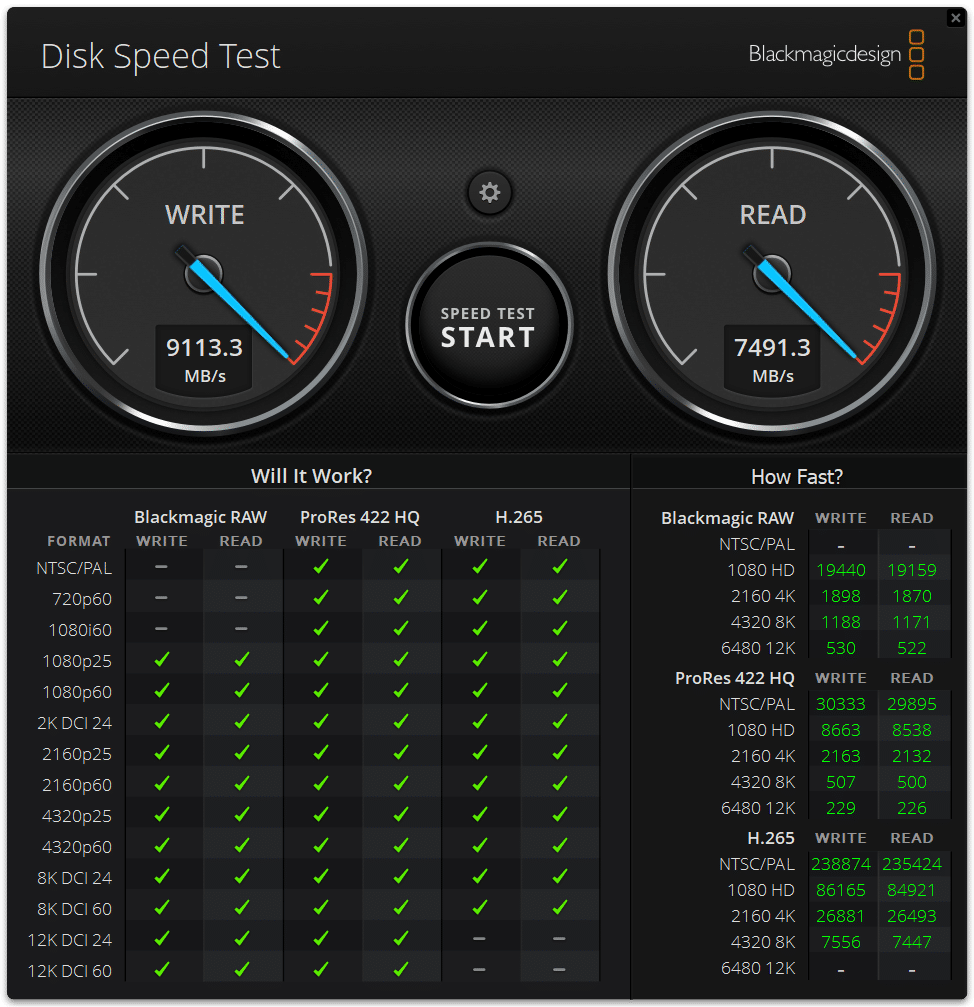
| Disk Speed Test | GIGABYTE Aorus 10000 | ADATA Legend 970 | GIGABYTE Aorus 10000 |
Seagate Firecuda 540 |
| Write | 9,113.3MB/s | 9,634.7MB/s | 9,661.0MB/s | 9,575.6MB/s |
| Read | 7,491.3MB/s | 6,755.6MB/s | 6,737.5MB/s | 6,746.5MB/s |
Conclusion
The AORUS 12000 Gen5 SSD arrives as an iteration over its predecessor, the AORUS 10000, featuring Micron’s new 232-layer NAND as its most notable change. It also features an MBTF rating of 1.6 million hours and comes in the usual M.2 2280 form factor. Ultimately, while this drive comes at a competitive price point, its performance doesn’t quite measure up to the expectations set by its PCIe Gen5 interface. While the AORUS 12000 Gen5 SSD might be an attractive proposition for those looking for a budget-friendly Gen5 drive, those prioritizing performance will can find better value elsewhere.
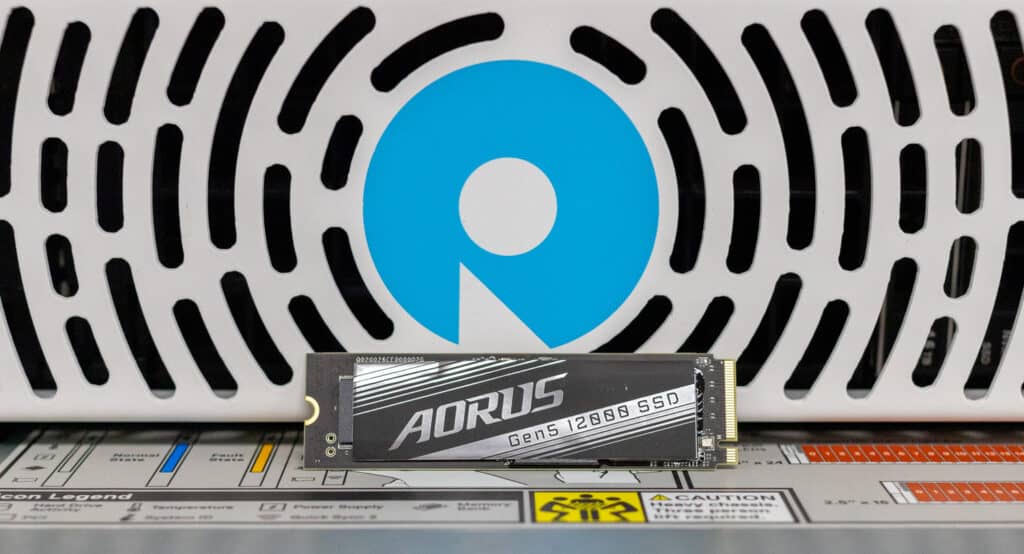
In terms of actual performance metrics, the AORUS 12000 lagged behind in most of our benchmarks, including 4K random read and write tests, as well as the VDI benchmarks. Results in these areas were often not just below the competition but also often its own predecessor. This isn’t all the surprising, however. This lack of competitive edge is consistent with other Gen5 drives using the same controller; they still can’t manage to outclass top-end Gen4 SSDs.
It’s important to note that for this review, we received the 1TB model of the AORUS 12000. In contrast, we benched the 2TB model of the AORUS 10000; the other drives we compared it to were also 2TB models. This difference in capacity could potentially influence the performance metrics, as SSDs often exhibit varying performance characteristics based on their capacity due to differences in NAND configuration and other factors. So, it’s possible that we might have seen slightly different results had GIGABYTE sent us the 2TB version for benchmarking.
Nonetheless, while it may offer some appeal with its optional thermal guard heatsink and robust build quality, this drive largely represents a disappointing update over the AORUS 10000, rather than a leap forward. At its current price, it does undercut the FireCuda 540 ($180), which uses older NAND, but the savings aren’t really enough to offset the relative performance drawbacks. This makes it hard to recommend over its more potent counterparts—or even its predecessor, the AORUS 10000—to both general consumers and performance enthusiasts.




 Amazon
Amazon